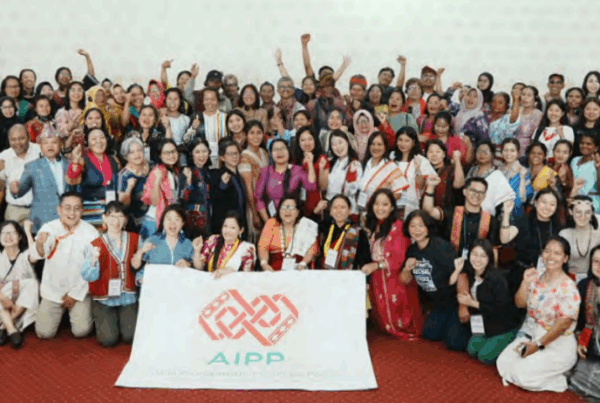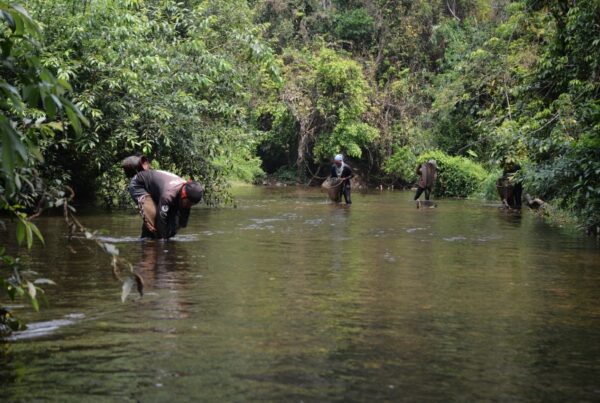Practical guidance for monitoring of natural resources by Indigenous Peoples and local communities.
This guide is for the local organisations working with communities (e.g. community-based organisations and local non-governmental organisations), which are facilitating Indigenous Peoples and Local Communities (IPs and LCs) to design and implement environmental and biodiversity monitoring activities on their lands. The guide includes approaches and considerations for all aspects of environmental monitoring, but with a particular focus on biodiversity monitoring in response to the needs and priorities set by partners of the Transformative Pathways Project.
Generally speaking, biodiversity monitoring is often motivated by a concern to ensure its long-term persistence, either because we value it for its own sake or to ensure the sustainable use of biodiversity as a resource. It may also be motivated by a desire to understand the positive and negative impacts of human activities on biodiversity, to develop more sustainable practices, or to provide evidence that existing practices of IPs and LCs are supporting biodiversity, for people or organisations outside communities.
Despite the growing emphasis within conservation policy and practice on enabling IPs & LCs to participate in conservation and sustainable use programmes, and despite awareness of the need to find deeper common ground between often seemingly divergent Western and indigenous values and priorities and focus on upholding people’s rights, the reality on the ground often does not reflect these aspirations. To address this gap, IPs & LCs may wish to monitor their biodiversity and seek technical support to do so, as well as to report on it in a way that is useful to them and that is also in line with external conservation approaches. Without external support, it may be difficult for some to enter locally-gathered monitoring data into national and international indicators of the state of biodiversity, either because the pathways to do this are unclear, the data collected are not considered robust or because they do not fit with the priorities or methods of external conservation actors.
We have developed this guidance to help local organisations working with IPs and LCs to develop community-based monitoring programmes in forests. These programmes often bridge the gap between indigenous peoples’ and local communities’ biodiversity management and external policies and practices. Our guide takes you through the key stages of designing and implementing a biodiversity monitoring strategy, including practical tips and signposting to other resources, so that you can build an understanding of the variety of approaches that can be used for biodiversity monitoring. Although the stages are set out sequentially, you will need to move backwards and forwards as the community refines its plan to achieve its monitoring objectives, depending on the resources available. By producing this guidance, we hope to help combine the best of western and traditional knowledges and values, which are equally valid, and are rooted in varying degrees and forms in the ancestral practices of indigenous peoples’ communities.
This guide is intended for use when a community has expressed a desire to monitor biodiversity, but wants additional support or facilitation to do so. This guide aims to help communities monitor both biodiversity of local importance for socio-cultural and economic purposes, and biodiversity of external conservation concern, such as species protected by national and international regulations and agreements. By monitoring biodiversity of importance both to local communities and to a wider conservation audience, IPs and LCs can more clearly demonstrate their role as environmental stewards, including to support their land claims, inter alia by demonstrating that they are the best guardians of their ancestral lands.
Enabling local organisations to better facilitate and support IPs and LCs will promote more robust community-based monitoring efforts. In turn, communities will be better equipped to independently develop and manage community monitoring programmes and community land-use plans. They will also be able to contribute sound evidence on the state of biodiversity on their lands to help shape local, national and international conservation policy, as well as contribute practically to biodiversity conservation and the sustainable use of natural resources.
Dashed line
Dashed line
Dashed line
Dashed line
Type: Report
Region: Africa, Asia and the Americas
Theme: Land and Resource Rights, Community-led Conservation, Biodiversity Monitoring and Traditional and Local Knowledge
Languages: , Français
Authors and Contributors: Stephanie Brittain, Helen Newing, Antuané de Fátima Cornejo Cardich, Maurizio Fahran Ferrari, Nilsa Yuliana Gómez Fernández, Bibiano Huamancayo Quiquín, Justin Kenrick, Fred Kibelio, Peter Kitelo, Elijah Kitelo, Mabel López Cruz, Phoebe Ndiema, Angela Paola Mera Mejía, Matías Pérez Ojeda del Arco, Tom Rowley, EJ Milner Gulland



